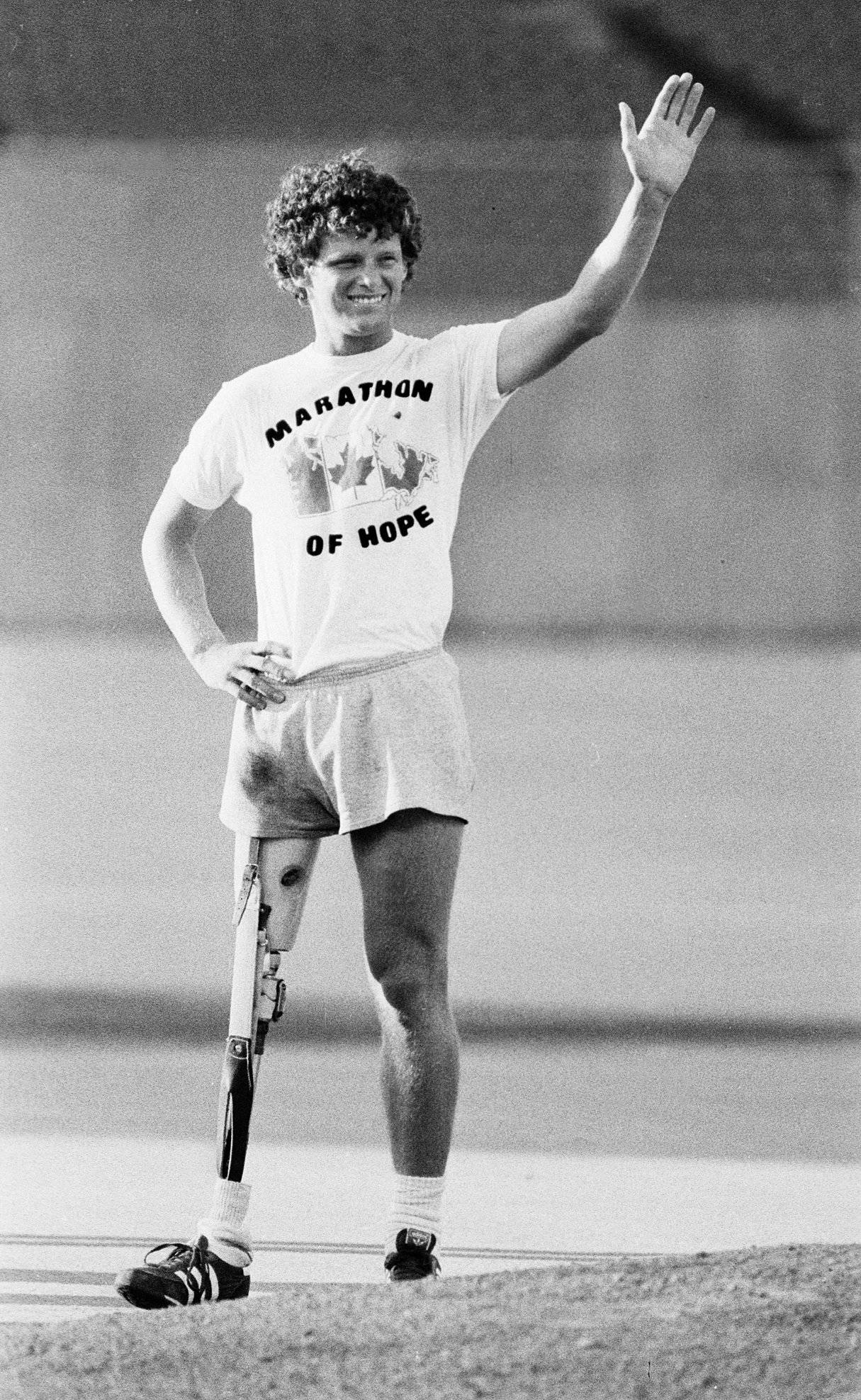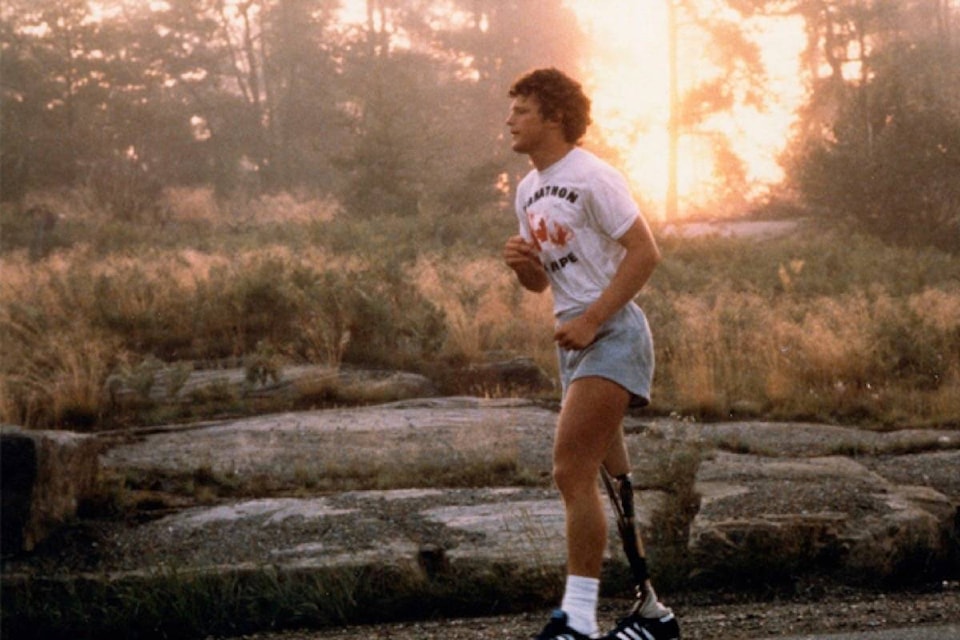Forty years ago, Terry Fox was no Canadian legend.
He was a 19-year-old cancer patient laying in a hospital bed the night before a surgery that would amputate his right leg above the knee, reading a copy of Runner’s World that his high school basketball coach had given him.
On the cover: Dick Traum, an above-knee amputee and the first runner to complete the New York City Marathon with a prosthetic leg.
“Terry, that night, dreamed of running across the country,” said Darrell Fox, Terry’s younger brother. “He said, ‘If this guy can run 26 miles on an artificial leg, then why can’t I?’”
The next 16 months of cancer treatment changed Terry irreversibly. The suffering that he witnessed during his time in the cancer ward would change him in ways he could never have predicted.
“Terry would often say that he was almost glad that he had been diagnosed with cancer, because before the disease he was very self-centred,” said Darrell. “But by experiencing cancer, and by seeing the suffering of others, he realized he was missing something in his life. And that was giving back.”
“He wanted to act on that. That’s where the whole idea of the Marathon of Hope really came from, was from what Terry witnessed going through cancer and seeing the suffering of others. People passing away, and him asking, ‘Why aren’t we doing more about this?’”
Two years after his operation, Terry began to run again. He ran half-miles in the dark, when no one could see him.
He didn’t tell his family about his idea for a cross-country run. Not yet. First he had to convince himself that he was capable.
Prosthetics in the late 1970s were nowhere near as advanced as they are today. Terry ran on a modified walking leg and he had to take an extra hop on his left leg to allow his artificial leg to swing through. The pressure not only on his good leg but on his stump was intense.
“His feet and his toes were always a mess,” said Darrell. “But he learned to deal with pain. He looked at it rather simplistically. He always reflected on those that he’d left behind in the cancer ward and he knew that they lived with pain 24 hours a day.”
READ MORE:
“They didn’t have a switch. They couldn’t shut it off. Whereas Terry realized he could. At any moment he could stop running and his pain would go away. So that was always an inspiration for him and always motivated him to keep going, realizing that there were those out there that just didn’t have that option.”
Terry ran every day for 101 days, until he could run 23 miles in a day. He ran more than 3,000 miles in preparation for the Marathon of Hope.
Terry finally told his family about his dream in 1979 after he completed a 17-mile race in Prince George.
He had finished the race in last place, but when he returned and told his family that he wanted to run across the country, it was a question of when, rather than how or why.
“You just knew,” said Darrell. “Me, being a younger brother who admired his older brother and who knew the kind of person he was. If Terry Fox had said he was going to run around the world, I would have believed him.”
A month later, Terry sent the Canadian Cancer Society a letter announcing his intention to run across Canada to raise money for the fight against cancer.
“The running I can do,” he wrote. “Even if I have to crawl every last mile.”
The Marathon of Hope
Darrell was 17-years-old when he flew across the country to join his older brother on the Marathon of Hope.
“There was no initial plan. I was in my final year of high school and it was late May — I was just really excited that I was going to miss a month of high school,” Darrell said, laughing.
“Not realizing, not understanding what I was about to be a part of,” he said.
It was a surprise for Terry. He hadn’t known Darrell was going to join the marathon until he saw his brother standing on the side of the highway, just outside of Saint John, New Brunswick
“It’s a memory that I’ll cherish for the rest of my life,” said Darrell. “You know, I’d seen Terry run. I ran with him at times on the track at Hastings Junior Secondary in PoCo. But that day, I’ll never forget that image.”
“Because you knew now that he was in the midst of fulfilling a dream. He looked even stronger than he ever did back training,” he said. “I thought he was invincible.”
Darrell got in the camper van with Terry’s friend Doug Alward, and the Marathon of Hope kept moving. At that point, Terry had been on the road for six weeks, and he had been receiving support and gentle encouragement from the Maritime communities he ran through. Nothing like they would see in Ontario, but vital support all the same.
Take Port-Aux-Basques in Newfoundland, for example. The small community, population 10,000, raised $10,000 for the cause, which gave Terry the idea of raising one dollar for every Canadian.
“It was like being on your favourite amusement park ride and the thrill of never wanting to get off. That was what every day was like, being on the Marathon of Hope,” said Darrell.
37 tears ago today: Terry is forced to stop his Marathon of Hope. Please donate in Terry's memory
— TerryFoxFoundation (@TerryFoxCanada)
“I was witnessing Canada the way no one had seen it before and I was also able to take in a nation embracing my brother and cheer him on,” he said. “It was so much good.”
Terry ran for 143 days, covering more than 5,300 km through six provinces. He was two-thirds of the way home to B.C. when he was forced to stop on September 1, 1980.
The pain in his chest had become too great, and he asked Alward to drive him to the hospital. The next day, Terry held a press conference and announced that his cancer had returned, and it had spread to his lungs.
“I never — I thought Terry would finish the Marathon of Hope,” said Darrell. “I didn’t think anything could stop him. But it did.”
“I try and focus on every day after. How the nation embraced Terry and came to his support, the telethon that happened in September of that year that raised over $10 million,” he said.
“He was as tough then as he was every day prior to that in terms of how he was going to approach it. He sent that message out there. If he could recover from it, he would, but if he didn’t, he hoped that the Marathon of Hope would continue. And it has.”
Today, there are annual Terry Fox runs in more than 20 countries around the world and the Terry Fox Foundation has raised more than $715 million for the fight against cancer.
“We’ve come a long way in those 37 years in terms of eradicating cancer. There’s a long way to go, but we’ve come a long way,” said Darrell.
“[Terry] believed that one person can make a difference. That limitations are self-imposed,” said Darrell. “Terry was just a very average individual. But through hard work and a never-give-up attitude, everything is possible.”
The Terry Fox Research Institute celebrates its 10th anniversary this October. Since it launched in 2007, the TFRI has collaborated with more than 60 cancer hospitals and research institutes across Canada.
Darrell is a Senior Advisor at TFRI. “We review research grants from across the country,” he said. “And with a heavy focus on team science. We want, like Terry brought the nation together in 1980, we want researchers … [and] institutions to come together, as opposed to competing against one another.”
“There are lots of great, quality research studies that aren’t being funded because of a lack of resources. So the foundation continues to fill a very large void in terms of supporting research out there,” he said.
“Terry’s not here, but he’s still our lead. He’s still giving us direction, we’re still following his road, his journey.”
To find where your nearest Terry Fox run is, visit




